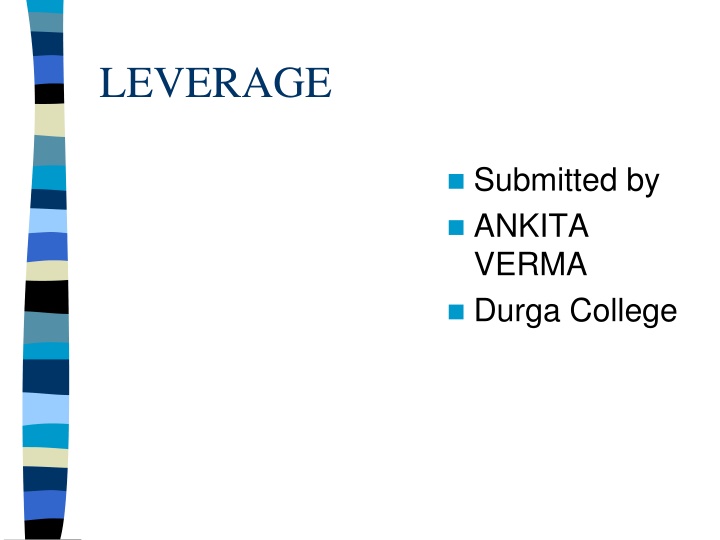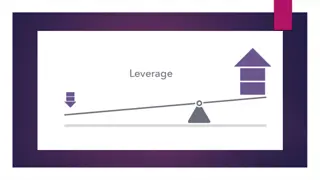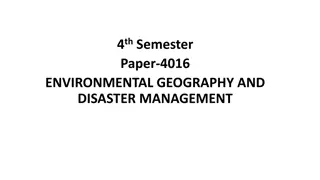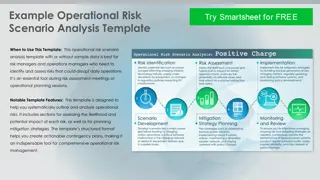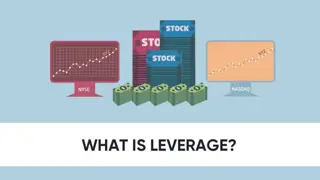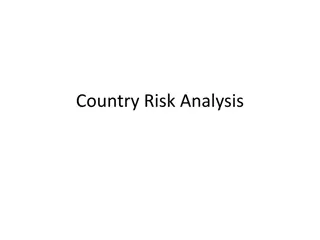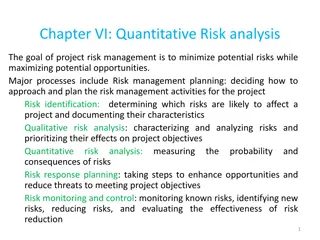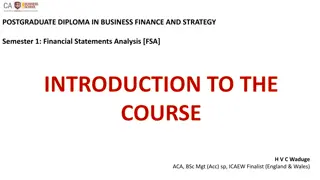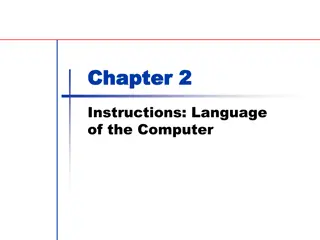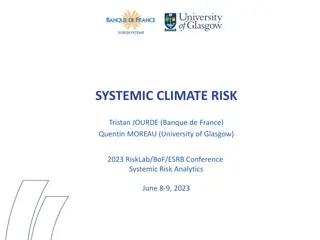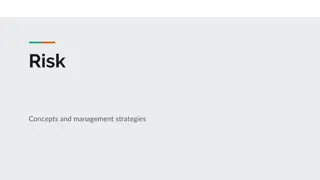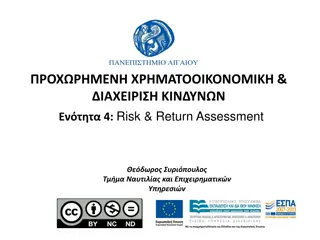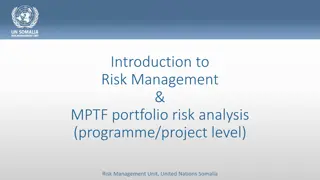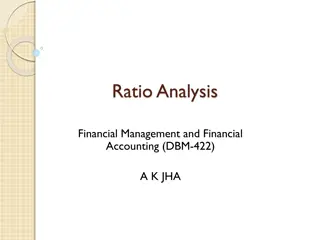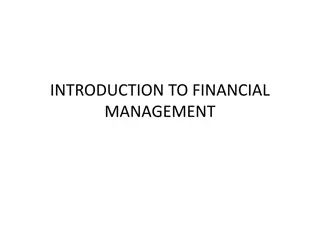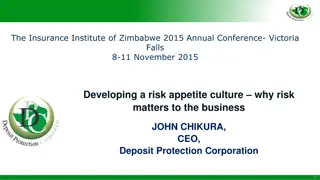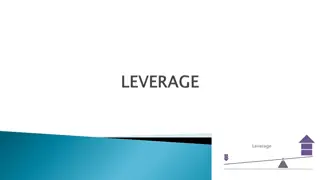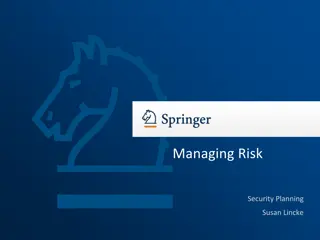Leverage and Financial Risk in Business Operations
Explore the concepts of leverage and financial risk in business with a focus on operating and financial leverage, business risk factors, and the impact of debt financing. Learn about employing leverage, leverage effects on earnings, and leverage analysis through an example income statement. Key symbols used in financial analyses are also explained.
Download Presentation

Please find below an Image/Link to download the presentation.
The content on the website is provided AS IS for your information and personal use only. It may not be sold, licensed, or shared on other websites without obtaining consent from the author.If you encounter any issues during the download, it is possible that the publisher has removed the file from their server.
You are allowed to download the files provided on this website for personal or commercial use, subject to the condition that they are used lawfully. All files are the property of their respective owners.
The content on the website is provided AS IS for your information and personal use only. It may not be sold, licensed, or shared on other websites without obtaining consent from the author.
E N D
Presentation Transcript
LEVERAGE Submitted by ANKITA VERMA Durga College
Operating and Financial Leverage Business and Financial Risk Employing Leverage Leverage and the Income Statement Operating Leverage and Business Risk Breakeven Analysis Degree of Operating Leverage Degree of Financial Leverage Degree of Combined Leverage Illustration of Leverage Effects
Business and Financial Risk Business Risk - Uncertainty inherent in the firm s operations if it used no debt. Major Factors Affecting Business Risk: Total sales variability Total fixed operating expenses Financial Risk Additional risk incurred through the use of debt financing.
Employing Leverage Leverage: Use of fixed cost items in the process of magnifying earnings. Operating Leverage: Use of fixed operating costs in the process of magnifying operating income (EBIT) Financial Leverage: Use of fixed financial costs (e.g., debt and preferred stock financing) in the process of magnifying earnings per share EPS. Our discussion focuses on the use of debt financing.
Leverage and the Income Statement Sales - Fixed costs - Variable costs EBIT - Interest EBT - Taxes EAT Note: EPS = EAT/(# shares) [assuming no pfd. stock] Operating Leverage Total Leverage Financial Leverage
Leverage Analysis: An Example Webb s Incorporated Income Statement (Year Ended December 31, 2002) Sales (30,000 units @ $25) - Variable costs ($7 per unit) - Fixed costs EBIT - Interest expenses EBT - Taxes EAT $ 750,000 (210,000) (270,000) $ 270,000 (170,000) $ 100,000 ( 34,000) $ 66,000 Given 20,000 shares outstanding: EPS = $66,000/20,000 = $3.30
Key to Symbols Used in the Following Analyses Note: The symbols used in the notes differ somewhat from the symbols used in the text. P = price per unit Q = sales in units V = variable cost per unit F = fixed costs VC = total variable costs TC = F + VC = total costs S = PQ = sales dollars EBIT = S - TC
Operating Leverage and Business Risk Calculating Breakeven Point in Units: (1) S - TC = 0 (2) S - F - VC = 0 (3) PQ - F - VQ = 0 (4) PQ - VQ = F = ( F Q ) P V Webb s Breakeven Point in Units: $270, $25 $7 000 F = = = 15000 units , Q ( ) P V
Calculating Breakeven Point in Dollars: F P V PF P V F 1-V P = (multiply both sides by P) Q = (divide numerator & denominator by P) PQ S= (multiply V/ P by Q/ Q) F VQ PQ $270, $210, $750, F VC S = = Result: S 1 1 000 000 000 F VC S = = = $375, 000 S 1 1
Breakeven Chart Thousands of Dollars 1200 S 1000 800 TC 600 400 200 0 0 15 30 45 Thousands of Units
EBIT Chart Thousands of Dollars 600 EBIT 500 400 300 200 100 0 Thousands of Units -100 15 30 45 -200 -300 -400
Degree of Operating Leverage % in EBIT in Sales % ( ( = DOL ) Q P Q P S EBIT V ) S VC = = V F S VC F VC = Note: If F = 0, DOL = 1 (i.e., without any F, the % change in EBIT would be equal to the % change in sales). By employing F, the firm s % change in EBIT will be greater than the % change in sales.
Webbs DOL When Q = 30,000 Units 30000 , ($25 $7) ($25 $7) DOL = = 2 0 . 30000 , $270, 000 For every 1% change in sales, EBIT will change 2%. Operating Leverage is Risky: If sales increase 5%, a DOL of 2.0 indicates that EBIT would increase 10%. On the other hand, if sales decline 7%, a DOL of 2.0 indicates that EBIT would decline 14%.
Degree of Financial Leverage % % in EBIT EBIT EBIT-I in EPS DFL = = Note: If interest expense = 0, DFL = 1.0 (i.e., without any debt financing, the % change in EPS would be equal to the % change in EBIT). By incurring interest expense (debt financing) the firm s % change in EPS will be greater than the % change in EBIT.
Webbs DFL When Q = 30,000 Units $270, $270, $170, 000 000 DFL = = 2 7 . 000 For every 1% change in EBIT, EPS will change 2.7% Financial Leverage is Risky: If EBIT increases 2%, a DFL of 2.7 indicates that EPS would increase 5.4%. On the other hand, if EBIT declines 4%, a DFL of 2.7 indicates that EPS would decline 10.8%.
Degree of Combined Leverage in % P Q EPS = DCL % Sales in V ( ) V = ( ) Q P F I S VC S VC = = S VC F I EBT EBIT in in % % EPS = Sales in EBIT in % % (DOL)(DFL) = Note: If F = 0, and I = 0, DCL = 1.0 (i.e., without F or I the % change in EPS would be equal to the % change in sales). By employing F or I (or both), the firm s % change in EPS will be greater than the % change in sales.
Webbs DCL When Q = 30,000 Units ) 7 30 000 , ( 25 = DCL ) 7 30 000 , ( 25 270 000 , 170 000 , (DOL)(DFL) = (2)(2.7) = = 5.4
Illustration of Leverage Effects (A 10% Increase in Sales for Webb s Inc.) Bef. Sales Inc. Sales (33,000 units @ $25) - Variable costs ($7 per unit) - Fixed costs EBIT - Interest expense EBT $ 154,000 $ 100,000 - Taxes EAT $ 825,000 $ 750,000 (231,000) (210,000) (270,000) (270,000) $ 324,000 $ 270,000 (170,000) (170,000) ( 52,360) (34,000) $ 101,640 $ 66,000 EPS = $101,640/20,000 = $5.08 EPS = $3.30
DOL = 2.0 324 000 , 270 000 , EBIT in = % = 2 . 270 000 , sales) in DFL 2.7 = = 2(% = 20% 5.08 - 3.30 in % EPS = = .54 . 3 30 EBIT) in DCL 5.4 = 2.7(% = = 54% 5.4(% = EPS in sales) in % = 54%
